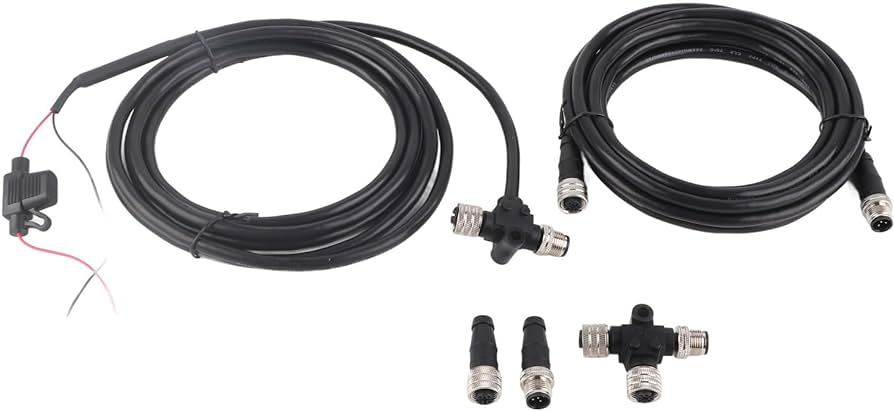What is NMEA 2000 and how does it work?

NMEA 2000 (National Marine Electronics Association 2000) is a standardized communication protocol used in the marine industry for connecting and interfacing electronic devices and systems on boats and ships. It provides a means for various marine electronic devices, such as GPS units, fishfinders, chartplotters, radars, autopilots, engine sensors, and more, to communicate with each other seamlessly.
Shop for NMEA2000 Cables, Sensors and Accessories
Here are some key points about NMEA 2000:
Standardized Communication: NMEA 2000 establishes a standardized communication protocol, ensuring compatibility and interoperability among different marine electronic devices from various manufacturers. This allows devices from different brands to share data and work together effectively on the same network.
High-Speed Data Transfer: NMEA 2000 networks operate at high speeds, enabling rapid and efficient transfer of data between connected devices. This is particularly important for real-time applications such as navigation, radar, and sonar systems, where timely data updates are crucial for safe and effective operation.
Plug-and-Play Connectivity: NMEA 2000 networks are designed for easy installation and configuration, with plug-and-play connectivity for most devices. This simplifies the process of adding new devices to the network or expanding an existing network, reducing installation time and complexity.
Multi-Device Support: NMEA 2000 networks support a wide range of marine electronic devices and sensors, including navigation instruments, engine monitors, fuel sensors, temperature sensors, and more. This allows for comprehensive integration of various systems on a boat or ship, providing users with a unified and cohesive operating environment.
Data Sharing: One of the key features of NMEA 2000 is its ability to facilitate the sharing of data between different devices on the network. For example, GPS data from a chartplotter can be shared with an autopilot system for precise navigation, or engine data can be transmitted to a multifunction display for monitoring and diagnostics.
Redundancy and Reliability: NMEA 2000 networks are designed with built-in redundancy and fault tolerance mechanisms to ensure reliable operation in demanding marine environments. This includes features such as multiple network nodes, data validation, error detection, and automatic device configuration.
Overall, NMEA 2000 plays a vital role in modern marine electronics by providing a standardized communication platform that enables seamless integration and interoperability of various electronic devices and systems on boats and ships, enhancing safety, efficiency, and convenience for boaters and sailors alike.
While NMEA 2000 is a widely adopted and highly beneficial communication protocol in the marine industry, it does have some limitations and disadvantages:
Cost: Implementing NMEA 2000 networks can be expensive, particularly for small boats or vessels with limited budgets. The initial cost of purchasing NMEA 2000-compatible devices, cabling, connectors, and network components can be significant. Additionally, there may be ongoing costs for maintenance, upgrades, and expansion of the network.
Complexity: Setting up and configuring NMEA 2000 networks can be complex, especially for those who are not familiar with marine electronics or networking principles. Proper installation requires knowledge of wiring, terminations, device compatibility, and network topology. Without adequate expertise, there is a risk of improper installation, which can lead to network issues or device malfunction.
Limited Compatibility: While NMEA 2000 is a standardized protocol, there may still be compatibility issues between devices from different manufacturers. Not all devices may fully support all features or data formats of the NMEA 2000 standard, leading to interoperability issues or limited functionality when mixing devices from different brands.
Data Bandwidth Limitations: NMEA 2000 networks operate at a fixed data rate, which may limit the amount of data that can be transmitted simultaneously, especially in larger and more complex networks with numerous devices. This can result in congestion or delays in data transmission, particularly during peak usage periods or when transferring large amounts of data.
Limited Range: NMEA 2000 networks are typically designed for use on small to medium-sized vessels, and the maximum cable length between devices is limited to around 200 meters (approximately 656 feet). This may restrict the coverage area of the network on larger vessels or require the use of additional network components, such as repeaters or extenders, to extend the range.
Dependency on Power: NMEA 2000 networks require a stable power supply to operate effectively. If there are issues with the vessel’s power system, such as voltage fluctuations or electrical failures, it can impact the reliability and functionality of the network. Additionally, power consumption by network devices may contribute to overall power usage on the vessel.
Despite these disadvantages, NMEA 2000 remains a popular and widely used communication protocol in the marine industry due to its standardized approach, interoperability between devices, and ability to facilitate seamless integration of marine electronics systems.
